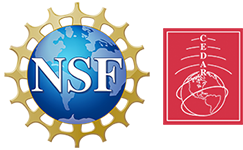On the importance of Joule heating and ion drag in the propagation of TAD induced by ULF waves
Both Joule heating and ion drag can drive TAD, but the relative importance of these two mechanisms in the TAD propagation has not been analyzed. We here present a modeling study of ULF wave effects on the neutral atmosphere by controlling its pathway: whether it is through energy process (Joule heating) or momentum process (ion drag). Modeling results indicate that ULF wave induced TAD is mainly carried by energy process rather than momentum process. TAD triggered by Joule heating can propagate to middle and low latitudes, while its counterpart triggered by ion drag is mostly confined to the forcing region. In driving temperature perturbations, Joule heating and adiabatic cooling are the dominant mechanism inside the forcing region, while only adiabatic cooling remains outside; In driving zonal wind perturbation, ion drag and pressure gradient force are the dominant force inside the forcing region, while only pressure gradient force remains outside. Pressure gradient force is the driving force for meridional wind perturbations regardless of the relative location to the forcing region. The modeling results also indicate that such TAD propagation is independent of seasonal effects.
